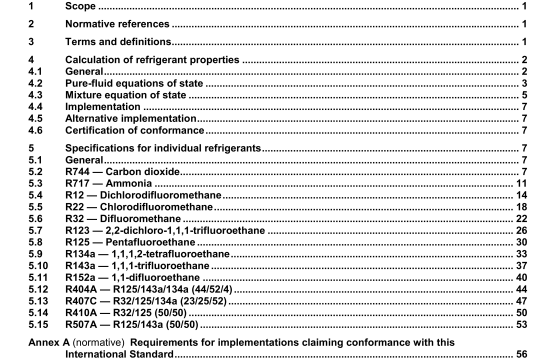ISO 17584 pdf download – Refrigerant properties.
NOTE An equation of stale most commonly expresses pressure or Helmhol(z energy as a function of temperataw, density, and (for a blend) composition. Other thermodynamic properlies are obtained through Integration ancVor differentiabon at the equation of Mate.
3.5
fluid
refrigerant
substance, present in liquid andlcx gaseous slates, used for heat transfer in a rengerating system
NOTE The fluid absorbs heat at a los temperature and low pressure, then releases the heat at a hier tei’nperatiire and a higher pressure, usually through a change of state.
liquid-vapour saturation
state at whid’t liquid and vapour phases of a fluid are in thermodynamic equilibrium with each other at a common temperature and pressure
NOTE Such Males exist from the triple point to the cfltlcal point.
3.7
transport properties
viscosity, thermal conductivity, and diffusion coefficient
3.C
thermodynamic properties
density, pressure. fugacity, internal energy, enthalpy. entropy. Gibbs and Helmholtz energies, heat capacities, speed of sound, and the Joule-Thomson coeffloent, in both single-phase states arid along the liquid-vapour saturation boundary
3.9
thermophysical properties
all of the thermodynamic, transport, and other misoelaneous properties
3.10
tripl, point
state at which solid, liquid, and vapour phases of a substance are in thermodynamic equilibrium
4 Calculation of refrigerant properties
4.1 General
This International Standard specifies properties for the refrigerants listed in Clause I These properties are derived from experimental measurements It is not practical however, to directly reference the experimental data; they may not be available at all conditions of interest and some properties, such as entropy, cannot be measured directly. Fixthermore, a simple tabulation, even for properties (such as vapour pressure) that are directly measurable, Is not convenient for modem englneenng use. Thus, some means to correlate the data Is required to allow calculation of the properties at a desired thermodynamic state.
The properties enumerated in this International Standard are calculated from speofied equations of slate. although alternative algorithms are allowed. The properties themselves constitute this International Standard. The equations of state serve as a convenient means to represent and reproduce the properties. The properties enumerated In the tables In this International Standard thus represent only a subset of the properties speofied by this International Standard; the full range of conditions Is given for each fluid in Clause 5. An equation of state Is a mathematical equation that Is a complete and thermodynamically consistent representation of the thermodynamic properties of a fluid, These equations have been selected based on the following criteria:
a) accuracy in reproducing the available experimental data;
b) applicability over wide ranges of temperature, pressure, and density;
c) proper behavior on extrapolation beyond the available experimental data; and
d) preference has been given to fuly documented and published formulations.
4.2 Pure-fluid equations of state
An equation of state for a pure fluid may express the reduced molar Helmholtz energy, A, as a function of temperature and density The equation is composed of separate terms arising from ideal-gas behaviour (subscrip( 1C) and a tesidual or real-fluid (subscnpt r) contnbution as given in Equation (1).
ISO 17584 pdf download – Refrigerant properties
